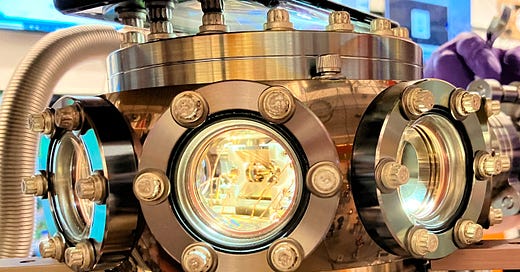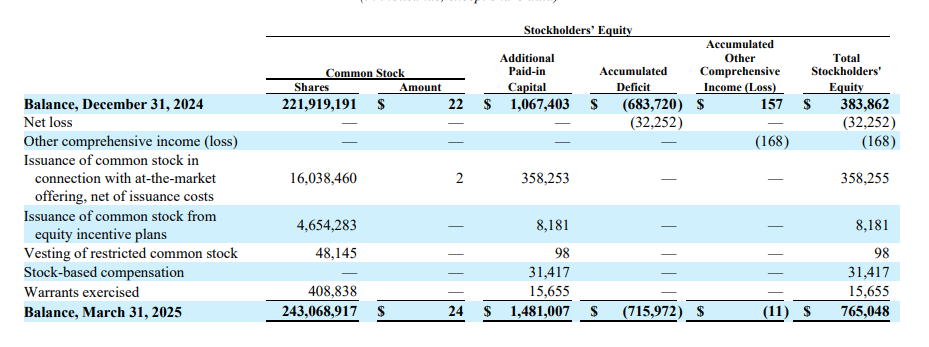IonQ: A Strong Story, but Still a Story
This article covers why IonQ surged +40% last week and whether this move is sustainable. It also gives an introduction on IonQ
Another week, another story about Quantum Computing. If you haven’t already, please check out my previous article covering Rigetti Computing as today I’m covering a competitor, IonQ, who recently made headlines. This announcement led to QC stocks exploding towards the end of last week despite the major indices being down. These QC stocks are all too small to be in the indices but it’s worth noting that they behave differently and aren’t entirely correlated with the broader market, to a given point. Let’s get straight into it.
Introduction
IonQ were formed in 2015 and have been public since 2021. The team is formed of academic researchers from the University of Maryland and Duke University, led by co-founders Christopher Monroe and Jungsang Kim, two of the field’s most respected quantum physicists. Monroe played a key role in demonstrating the first quantum logic gate in the 1990s, while Kim previously worked on quantum systems at Bell Labs. The company spun out of academic research with the goal of commercialising trapped ion quantum computing, a less conventional approach compared to the superconducting systems being pursued by Google and IBM. Since then, IonQ has positioned itself as one of the leaders in the space, with systems already deployed via the cloud and a commercial roadmap that now includes photonics and error correction.
The trapped ion approach is completely different from the superconducting qubit, while still trying to achieve the same goal of scalable, fault-tolerant quantum computing. An ion is simply an atom that has lost or gained an electron, giving it an electric charge. That charge allows it to be controlled using electromagnetic fields. At its core, trapped ion quantum computing involves isolating ions in a vacuum chamber using electromagnetic fields. These ions can be manipulated using lasers to perform quantum operations. The quantum bits, or qubits, in this system are represented by the internal energy states of the ions. By controlling the interactions between these ions with precise laser pulses, complex quantum algorithms can be executed. Each ion is suspended in space, not touching anything, and held perfectly still using radiofrequency and static electric fields. Lasers are used not just to flip the qubit between energy states, but also to place it into superpositions and to entangle it with neighbouring ions. These interactions are coordinated through the ions’ shared vibrational modes, allowing the system to build entangled states across multiple qubits. The entire setup is kept in ultra-high vacuum to avoid any interference, with stability and control systems ensuring that even the slightest environmental noise doesn’t disrupt the quantum states. I’m not a quantum physicist so that’s as deep as I’ll go, but if you’re interested in a more scientific explanation, IonQ do a good job on their website.
Business
IonQ builds and operates quantum hardware, offering access to it through major cloud platforms. These systems are not sold or shipped to clients. Instead, users connect remotely via AWS, Microsoft Azure, or Google Cloud and pay to run quantum circuits on demand. This model, often described as quantum-as-a-service, avoids the complexity of deploying quantum hardware on-site and allows for broader commercial reach. It also means that hardware performance, uptime, and upgrades are all managed internally, creating a single environment for both experimentation and production testing.
Outside of public cloud access, IonQ signs direct contracts with government bodies, corporations and research institutions. These are often multi-year deals with reserved access or specific collaboration goals. Clients are typically focused on quantum simulation, machine learning, or optimisation problems that are too large for classical methods. Names like Hyundai, Airbus, and the US Air Force have appeared in filings and public partnerships. These deals make up the bulk of IonQ’s revenue backlog and are essential to proving commercial demand while the hardware continues to improve. Hardware development follows a named roadmap, with systems like Harmony, Aria, and Forte reflecting each new generation. Each system increases the number of available algorithmic qubits and reduces error rates through improved control and calibration. Research and development isn’t a side project. It is the core of the business. Most of the current engineering effort is focused on building scalable, fault-tolerant systems. The belief is that high-quality qubits combined with an efficient control layer can eventually outperform noisy intermediate-scale quantum approaches being used elsewhere.
Financials
Just like every other quantum computing business, IonQ are running at a consistent loss. But I think out of all of the pure QC companies, their balance sheet is definitely one of the best. Total equity sits at $765mn, up from $384mn at the end of last year. This is thanks to a $358mn raise through an at-the-market offering programme, which they terminated in March after quickly filling the book. What this means is that, despite the losses, they have enough capital for now to continue investing in hardware and headcount without needing to issue more stock in the immediate term. Their cash, short-term, and long-term investments now total close to $650mn, while total liabilities are just $85mn. That means nearly every dollar of assets is funded by equity, not debt. That kind of balance sheet strength is rare for a business still in the early stages of commercialisation. It gives them room to absorb continued losses, ramp R&D, and build out hardware capacity without having to rely on external funding or issue more shares anytime soon. In an industry where most peers are constantly raising just to stay afloat, IonQ are in a stronger position.
Q1 2025 revenue came in at $7.6mn, flat YoY. The topline continues to move slowly, which isn’t surprising given how early the market is for quantum-as-a-service. Revenue is still largely driven by a mix of cloud platform access, bespoke consulting work, and small-scale hardware engagements. The commercial model is intact, but it is not yet scaling. What matters at this stage is not growth, but whether customers are returning and whether the backlog is growing, both of which appear to be true.
Net loss for the quarter was $32.3mn, a modest improvement from the $39.6mn loss recorded in the same quarter last year. On the surface, it’s still a heavy burn. But most of that is driven by deliberate investment. R&D spend for the quarter came in at $40mn, which is nearly two-thirds of the operating budget. This isn’t spend on overhead or sales. It’s capital directed straight into system design, control software, and fault tolerance, the parts of the stack that will matter if IonQ wants to lead the next generation of hardware.
It’s also worth pointing out that stock-based compensation accounted for $31mn of total expenses. That’s a huge number relative to revenue and even to cash burn. If you strip that out, the adjusted operating loss looks significantly smaller. Whether or not you back it out depends on how you view dilution, but from a cash flow standpoint, it softens the actual outlay. IonQ are using equity to fund engineering talent, and while that may weigh on shareholders in the long run, it gives the business a clean way to finance deep tech development in the near term.
So overall, pretty okay given the context. But why did shares surge +~40% last week? Was there a new breakthrough? Did they build a quantum computer with several commercial applications?
Stock Surge
No, their CEO, Niccolo De Masi, simply went on TV and said something along the lines of “We want to be the NVIDIA of quantum computing”. That’s it. That is literally why IonQ and several other quantum computing stocks rallied last week. What Niccolo De Masi said was promising, but at the end of the day of course he is going to talk big because he wants to promote the company. And with so much equity funding on the balance sheet, a high share price is valuable. It makes future raises easier, keeps the cost of compensation lower, and buys more time.
Shares have been grinding higher since the massive selloff at the start of the year. I think that at some point this year, perhaps soon, there will be a new ATH. But volatility comes with all of the quantum stocks and the moves can be wild, therefore, like I said in my previous article, I would treat this more like a trade than an investment. At a market cap of $11.3bn, IonQ are trading on a price-to-sales multiple of over 240x. That’s clearly not being driven by current fundamentals, but rather by expectations around where the technology could go. With just $7.6mn in quarterly revenue and no profitability in sight, this is still very much a future-looking story. And while I can see why someone might back that story at these levels, it just isn’t for me, at least not here. I’d prefer to wait for either a reset in price, which I’m almost certain of there being one across the quantum computing realm, or more evidence of real commercial traction. The balance sheet is strong, the roadmap is ambitious, and the interest is clearly there. I just don’t need to or want to be involved at this valuation. Of course, everyone has their own ideas and risk tolerance.
Outlook
IonQ are targeting the launch of Tempo later this year, a system designed to reach 64 algorithmic qubits, up from the 36 currently available on Forte. If delivered, this would mark a significant step forward in usable quantum capability. They are also expanding into quantum networking through acquisitions like Qubitekk and ID Quantique, which add both hardware and IP focused on secure communications and entanglement distribution. Alongside this, IonQ are participating in DARPA’s Quantum Benchmarking Initiative, a government-led programme aimed at defining what utility-scale quantum computing should look like. For the full year, revenue is projected between $75mn and $95mn, suggesting a meaningful pickup in commercial activity from the $7.6mn posted in Q1.
It’s all moving in the right direction, but I still think most of this is being priced ahead of time. The fundamentals haven’t caught up to the story yet, and while the ambition is clear, I’d rather see a bit more delivery before taking it seriously as an investment. The moves will probably stay sharp in both directions, and that’s fine but it remains on the watchlist for now!
I hope you found this article both engaging and informative. If you know someone who might find this article interesting, passing it along would mean a lot and helps grow the page. Thank you for reading and stay tuned for the next article!
Disclaimer: This article is for informational purposes only and should not be considered financial or investment advice. The views expressed are my own and based on publicly available information, market trends, and personal analysis. Readers should conduct their own research and consult a financial professional before making any investment decisions.








